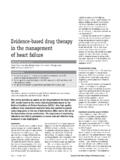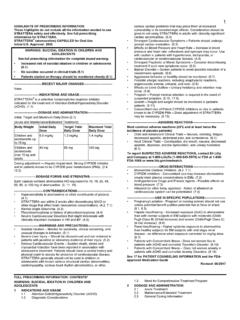Transcription of Drug-induced peptic ulcer disease - mcppnet.org
1 Issue 10 Summer 2005 Journal of the Malta College of Pharmacy Practice 15 IntroductionFollowing the discovery of theassociation of peptic ulcer disease withHelicobacter pylori infection there has beena decline in the prevalence ofuncomplicated peptic ulcer disease . Incontrast, a striking rise in admissions forulcer haemorrhage and perforation amongelderly people is now being observed. Thisrise has been attributed to the increaseduse of non-steroidal anti-inflammatorydrugs (NSAIDs) and low-dose Drug-induced peptic ulcers are not exclusive toanti-inflammatory drugs, other medicinessuch as bisphosphonates, potassiumDrug- induced pepticulcer diseaseClinical Pharmacist, St Luke s Hospital, Guardamangia, MaltaEmail: words: peptic ulcer , medicines, prostaglandins, gastrointestinal protection,gastrointestinal toxicityFor more than a century, peptic ulcer disease has been amajor cause of morbidity and peptic ulcer diseaseis a heterogeneous group of disorders involving thegastrointestinal tract and results from an imbalance betweenthe aggressive forces of gastric acid and pepsin and thedefensive mechanisms of the gastric ,2,3supplements, corticosteriods, anticoagulantsand chemotherapy play a anti-inflammatorydrugs (NSAIDs)
2 Commonly prescribed for a variety ofmusculoskeletal complaints such asrheumatoid arthritis and short-termmanagement of pain in osteoarthritis, 4,5 NSAIDs are associated with both upper andlower gastrointestinal tract rates vary significantly6 asestimates do not make a distinctionbetween causal and non-causal associationsor because estimates are observed in high-risk populations The prevalence ofendoscopically confirmed gastrointestinalulcers in NSAID users is quoted to bebetween 15% and 30%. Between 12% to30% of NSAID- induced ulcers are gastriculcers, whereas 2% to 19% are duodenalulcers. NSAID- induced ulcers aresymptomatic only in 1% of patients afterthree to six months and in 2 to 4% ofpatients after one year. Inappropriatelythey do not correlate well with pain becausethe analgesic action of NSAIDs may maskthe ulcer the method by whichNSAIDs cause gastric damage has helped inthe development of prophylactic agents thatre d uce their The mechanism bywhich NSAIDs are thought to damage thegastrointestinal tract is ) Topical injuryOriginally it was thought that NSAID sdam aged the gastric epithelium byintracellular accumulation of these drugs inan ionised However the fact thatenteric-coated formulations, pro-drugs,rectal and parenteral administration ofNSAIDs still resulted in gastrointestinaldamage despite the apparent absence ofdirect mucosal contact implies a minor rolefo r topical injury1, )
3 Inhibition of prostaglandin synthesisIn 1971 Vane discovered that NSAID sact by the inhibition of cyclooxygenase theenzyme that converts arachidonic acid toprostaglandins. As prostaglandins play amajor role in the maintenance ofgastroduodenal defence mechanisms; theirdepletion due to NSAIDs and aspirin impairscytoprotection resulting in mucosal injury,erosions and , 8c) Nitric OxideRecent attention has focused on therole of nitric oxide (NO) in maintenance ofgastric-mucosal blood Likeprostaglandins nitric oxide has been shownto increase mucosal blood flow, stimulatemucus secretion and inhibit neutrophilValerie Vella B Pharm(Hons), PgDip Clin Pharm (Aberdeen)16 Journal of the Malta College of Pharmacy PracticeIssue 10 Summer In animals NO-releasingNSAIDs produce less gastric damage thantheir parent drugs and they even ,9d)
4 Neutrophil-mediated injuryNeutrophil adherence to theendothelium of gastric microcirculationdamages the mucosa by liberating oxygen-free radicals, releasing proteases andobstructing capillary blood flow. NSAID sare thought to stimulate neutrophiladherence by up-regulation of overall result is that NSAIDs causedamage as they impair the ability of thegastrointestinal mucosa to respond Not all NSAIDs have the samepotential to cause peptic ulcer disease , infact ibuprofen in low doses (up to 1200mgdaily) is said to have the same Odds Ratio2as paracetamol in causing uppergastrointestinal Diclofenac alsohas a low odds ratio although higher thanthat for ibuprofen. Indomethacin,naproxen and piroxicam have anintermediate odds ratio whereasazapropazone and ketoprofen, has a veryhigh odds ratio, and should thus beavoided in high-risk patients7, 8,10,11,12,13 Cyclo-oxygenase (COX 2)selective inhibitorsThere are at least two isoforms ofcyclo-oxygenase: COX 1 and COX 2.
5 Thefo r m e r is found in high concentrations inplatelets, vascular endothelial cells, thestomach and in kidney collecting tubulesand is responsible for the prostaglandinswhich are essential for maintenance ofnorm al endocrine function, renal function,gastric mucosal integrity and 2 is significantly increased byinflammatory and mitogenic stimuli. Byselectively blocking COX 2, COX 2 selectiveinhibitors have a theoretical advantageover the traditional NSAIDS with respect tore d uc t ion in GI ,14 Publishedclinical trials assessing the gastroerosivepotential of coxibs demonstrate conflictingdata. 9, 15, 16,17 Cyclo-oxygenase inhibitingnitric oxide donatorsCOX-inhibiting nitric oxide donators,CINODs, are a new class of analgesic drugsdesigned to provide analgesic efficacythrough COX-inhibition andgastrointestinal safety through theprotective effects of controlled nitric oxidedonation9,18.
6 AZD3582 was the first CINODto enter clinical Althoughinitial reports were promising, a recentstudy has indicated that the muchexpected superior gastrointestinaltolerability of AZD3582 is no better thanthat provided by from its use as an anti-inflammatory, aspirin in low dose isfrequently indicated for the secondaryprevention of thrombotic cerebrovascularor cardiovascular ,5,21 Incidence ofpeptic ulcers has been reported to be ashigh as 35%.7 Advising patients to takeenteric coated tablets or to take thepreparation after food may minimisegastrointestinal symptoms as dyspepsia,but as for NSAIDs ulceration is mainlyattributable to its systemic effect onprostaglandin Co-prescriptionof aspirin with standard NSAIDs augmentsthe risk of such complications and riskreduction of upper gastrointestinal eventsassociated with COX 2 selective inhibitorsmay not be evident when they arecombined with is an antiplatelet drugindicated for the prevention ofatherothrombotic events in patientssuffering from myocardial infarction,ischaemic stroke or established peripheralarterial.
7 22 It is also given incombination with aspirin in patientssuffering from non-ST segment elevationacute coronary The risk ofgastric and duodenal ulcers with clopidogrelis between Unfortunatelyclopidogrel is not a solution to patients whoare unable to take aspirin because ofgastrointestinal complications. A number ofsmall studies have in fact revealed that inpatients with a history of bleeding andpeptic ulcer the combination of aspirin anda proton pump inhibitor is safer thanclopidogrel in terms of bleeding such as alendronate,etidronate and risedronate, are now usedextensively in the treatment of patientswith osteoporosis and Paget s disease andprophylaxis of ,25 Allbisphosphonates cause gastrointestinalside-effects14,26 however post-marketingsurveillance indicated that alendronate andrisedronate are associated with severeoesophageal reactions and gastric andduodenal ,25,27,28,29 It is unclearwhether variation in ulcerogenic potentialreflects differences in dosing.
8 Formulationor chemical with alendronate indicate thatthe oesophageal damage is consistent witha topical irritant Failure ofalendronate tablets to pass through theoesophagus may result in prolonged localmucosal exposure to the drug , leading toerosive or ulcerative mucosal damage withinflammation and thickening of theoesophageal For most part suchreactions can be avoided by appropriateadministration of the alendronate include swallowing the tablet wholewith plenty of water (not less than 200ml)on an empty stomach at least thirtyminutes before food while sitting orstanding. Patients should also be remindedto stand or sit upright for at least one hourafter taking the On the other handgastroduodenal injury appears to be anacute phenomenon not associated withsignificant complications, except in high- Odds ratio (OR)
9 Is defined as the odds of an event happening in the experimental group expressed as a proportion of the odds of an event happening in the control OR is greater than one, then the effects of the treatment are more than those of the control Journal of the Malta College of Pharmacy PracticeIssue 10 Summer 2005risk situations such as the presence ofmotility disorders or concurrent use ofNSAIDs or In a small studycarried out on 26 healthy volunteers therisk of gastric ulcers in patients takingalendronate and naproxen increased to 38%compared to 8% in those receivingalendronate supplementsPotassium chloride in some of its solidforms may be retained in a fixed locationwithin the oesophagus resulting inoesophageal haemorrhage. It is thoughtthat oesophageal injury is caused by thewax-matrix of slow release tablets.
10 Thesetablets should be avoided in patients withsignificant cardiomegaly particularly thosewho have undergone cardiac surgery asthese conditions seem to favour tabletreten tion in the oesophagus. They shouldalso be prescribed with caution in patientswith a history of peptic should always be advised toswallow potassium chloride tablets wholewith fluid during meals while sitting controversial over the years,current evidence suggests thatcorticosteriods alone do not impartdetectable risk for peptic the product characteristics ofcommonly used corticosteriods still indicatethat they should be used with caution inpatients with a history of ,35 Additionally they state thatcorticosteriods may be responsible forpeptic ulcers with possible perforation ,35 Corticosteroids may exacerbate NSAID- induced ,34.



